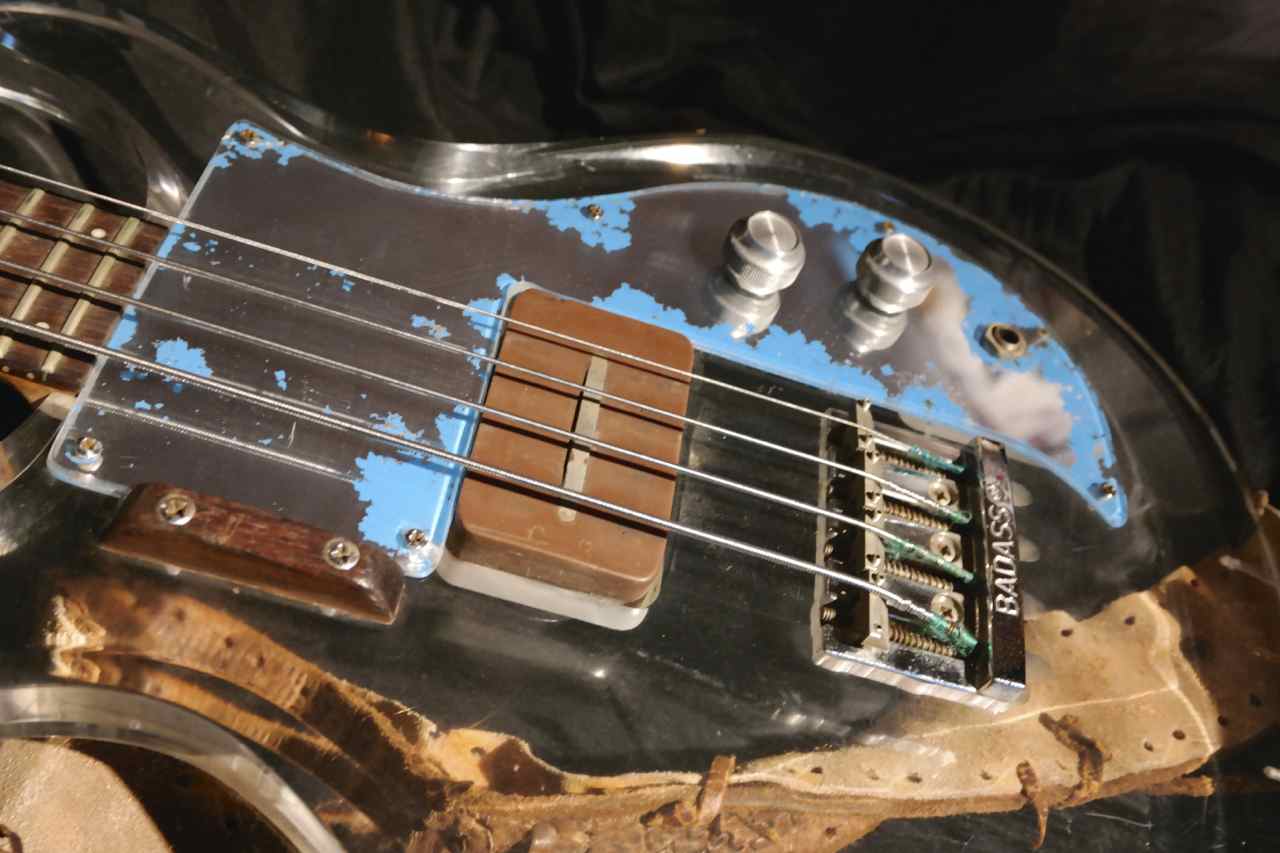For the origins of the Dan Armstrong bass, it is highly recommended to first read through the guitar section, for with the guitar prototype completed, building the bass guitar was going to be a somewhat easier task as Dan & Matt didn't have to 'invent the wheel' all over again. Like the guitar model the bass prototype was all hand built by Matt Umanov and although the overall body dimensions were identical the routing within the body needed to be changed as unlike the guitar model, the bass guitar did not utilize interchangeable type pickups. Thus the largest difference between the guitar body and the bass body is the noticeable lack of the sweeping pickup channel in the body.
As a result of this difference the routing of the control cavity had to be different. And it was here that Dan delegated the project to Kurt Munkacsi, who stated 'I only got in on a small part of the plexiglas instruments as Dan gave me the project of finding a way to hook up the bass pickup to the volume and tone control wiring.'
Kurt designed it so that there was a small section of the control cavity that wasn't routed as deep as the rest, giving the ability to allow a good mechanical, and electrical connection from the pickup to the rest of the instruments circuitry. |
At left, a very early bass guitar, probably at, or very close to - the end of the prototype stage of developement. Notice the light blue lining of the case - which is a common theme among the earliest cases - and which also feature a more squared shaped type of carrying handle.
Seen better in the enlarged view, notice straight headed screws securing the tailpiece to the body. Notice too, an un-sandblasted tailpiece and a somewhat wider, oversized rosewood saddle compared to later models. But the real surprise, to me, is the white etched-in lettering on the scratchplate - which shows the Dan Armstrong name only - the Ampeg name surprisingly missing.
At upper right, and also seen best in enlarged view, a very odd shaped, and deeper routed control cavity. Notice the aluminum foil type shielding applied to the bottom side of the scratchplate. This is another common theme among the earliest made basses. Why this practice was discontinued is unknown. Perhaps Dan (or Ampeg) thought it didn't make enough of a difference to continue with it.
Another oddity can be seen where the pickup resides in the acrylic body. Seen here from the backside, notice a small strip of what appears to be a piece of the faux-wood scratchplate material residing underneath the pickup. It is unknown for certain, but a good guess is that it is being used as a spacer, to build up the height of the pickup - which would seem to suggest that maybe the pickup cavity was routed too deeply.
At upper left, another indicator of a very early bass model - a chrome plated plate that utilizes two screws driven into the body to help secure the bass pickup in place. The pickup itself gives signs of an early model, for if you look closely you will notice that it is totally encased in resin. While this is not uncommon, what is uncommon, is, that even the metal pole piece is encased with that resin. Seen better in enlarged view is another oddity of sorts. Notice how the scratchplate curls up a touch just before it meets with the chrome plated pickup retaining plate.
At upper right, a black plastic thumb rest is equipped on these early models, whereas later models sport rosewood type thumb rests. Unknown to many is that on these early models the thumb rest is not centered on the top portion of the scratchplate, but rather are located further back, toward the pickup.
At upper left, the large flared out shoulders of the headstock are quite obvious compared to later models while at upper right, and as seen from the backside, the flared shoulders are even more obvious. Also notice how the low 'E' string tuner has been fitted out with a Grover Rotomatic tuner, whereas the rest are probably the original Schaller tuners.
At upper left, the same bass in an indoor setting. Notice again - only the name Dan Armstrong on the scratchplate. Notice too, the lack of any beveling in the cutaways like later models feature. At upper right, and seen from the backside, again the faux-wood material can be seen under the pickup. Like the guitar model, these earlier made basses feature a smaller type channel in the body that was routed for the ball-end of the strings to reside in. By the late 1970s the channel would be enlarged - both on the bass and guitar models. Notice again the placement of the thumb rest and the aluminum foil shielding that has been added behind the scratchplate.
Another very early bass guitar featuring a case with a light blue inner lining. Notice how the blue lining is beginning to separate from the top cover of the case. Notice how the case also features the more squared off handle and leather strap that secures the lid of the pick compartment.
At upper right, the squared off handle features a metal base portion that can be seen here. These features would soon give way to a newer style case featuring a more rounded off handle and a metal hook inside replacing the leather strap that secures the lid to the pick compartment.
continue
menu
Names and images are TMand © Dan Armstrong / Ampeg. All rights reserved.
All other names and images are TMand © of their respective owners. All rights reserved.
|
|

